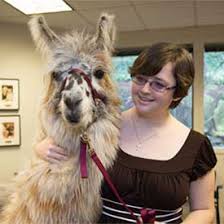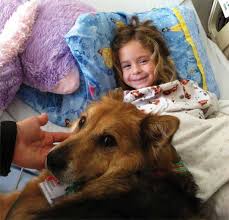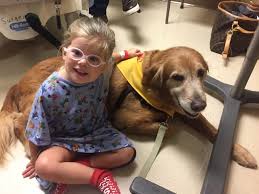Today SevenPonds is pleased to speak with Elisabeth Van Every, the Communications and Outreach coordinator at Pet Partners, an organization that facilitates animal-assisted interventions, including animal-assisted therapy.
The mission of Pet Partners is to improve human health and well-being through the human-animal bond. To achieve their mission, Pet Partners offers animal-assisted interventions including a therapy animal program in which human and animal teams interact with a variety of clients. Pet Partner volunteers work with veterans with PTSD, seniors living with Alzheimer’s, students with literacy challenges, patients in recovery, people with intellectual disabilities, and those approaching end of life.
Editor’s note: This interview has been edited for length and readability.

Elisabeth Van Every with Fezzik
Melissa Gouty: Tell me, Elisabeth, what brought you to Pet Partners and how you ended up being the marketing and strategic partnership director there?
Elisabeth Van Every: I’m originally from the Seattle area, but I spent three years living in New Jersey, thanks to my spouse’s job, and we decided that we wanted to return to Seattle. A friend of mine works for Pet Partners and thought I would fit in well here. I’m very passionate about pets and very passionate about doing something that brings good into the world, and I thought this seemed like a great organization.
I originally worked in our program operations department. Then about a year-and-a-half ago, I transitioned into communications and strategic partnerships, where I have the opportunity to spread the message of Pet Partners to the world.
In terms of my own volunteering, I am currently a docent with the zoo in Seattle, so I’ve got practice in communicating concepts effectively with a lot of empathy. Empathy is so important in any circumstance where you’re dealing with animals. That’s a big part of what I try to do when I’m talking about Pet Partners — to communicate the empathy that exists between the people and the animals in our therapy animal program and why that’s such a crucial part of our mission.
Melissa: What’s the organizational structure of Pet Partners? How do your volunteers find gigs? Are they assigned to specific places?
Elisabeth: We want to give our volunteers the opportunity to volunteer at the places that work for them. Our program is nationwide, and actually in several other countries as well, although the international program is fairly new. Any place that would like to have a therapy animal team visit is open to a Pet Partners team. Our volunteers have the opportunity to reach out to facilities that they’re interested in.
We do provide a directory for our volunteers where facilities can post requests, and our volunteers can browse that directory and choose opportunities from that if they would like to do so.
Melissa: You mentioned international work. So you’re branching out worldwide?
Elisabeth: Yes. We are currently on five other continents. The first two countries where we did training exercises were Colombia and South Korea. We’ve also done them in Switzerland, where we trained people from a number of other countries in Europe, including France, Italy, Romania, and Greece. We have an evaluator and a couple of teams in Australia.
Our organization has been in existence in some form since 1977, but the international program is brand new. We’ve certainly had a reputation in the field for a number of years because we were one of the earliest leaders in the field of animal-assisted interventions. Many professionals in other nations were aware of Pet Partners, but the opportunity to register with us has just come about in the last couple of years.
Melissa: I’ve heard that therapy dogs have to be extremely well-behaved and be considered “neutral” dogs who will NOT want to go smell something or who will not want to greet another animal. My dog is a wonderful dog but she would never pass that test!

Credit: Pet Partners
Elisabeth: Yes. I like to tell people that I don’t currently have a pet that’s suited to be in our therapy animal program. During the time that I’ve worked here, I’ve had two German Shepherds, and like to use these as a great example of what we’re looking for in a therapy animal. The German Shepherd I had when I started was beautifully trained. She was originally trained as a protection dog so she would obey every command. She could be relied upon in any circumstance, but because her training was as a protection dog, her focus was on HER people. She was not friendly to other people or to other animals, and that made her not a good fit for the program.
My current German Shepherd… he loves everybody. He’s very friendly. He loves getting loved. He’s got exactly the right personality for our program. We’re still working on the obedience!
Melissa: What is the role of diverse animals in your program? You have miniature horses, llamas, and rabbits. How big a role do those animals play, and do they have a different impact than a traditional dog would?
Elisabeth: Currently, species other than dogs are a small percentage of our total registrations. Ninety-four percent of our registrations currently are dog teams. The rest are all of the other species. We actually have more Golden Retrievers and Labs registered than we do all of the other species.
We register different species because they have demonstrated that they can be beneficial as therapy animals. For example, there are people who aren’t particularly fond of dogs and consider themselves cat people. Those people really appreciate the opportunity to interact with a cat versus a dog. Even if you like both animals, a cat can provide a different kind of experience. Dogs, particularly bigger dogs, can be very energetic and engage in lots of activity. A cat is a little more suited for sitting on your lap, taking a nap with you, sitting there calmly while you pet it.

A llama interacts with a Pet Partners volunteer
Credit: Pet Partners
With some of the other species, novelty plays a role. People are not necessarily expecting that they’re going to see a cockatoo or a llama or a miniature horse come to their room. But that can be a really engaging aspect for some people. Some people also respond better to a certain species than others. We’ve found that rabbits are particularly effective for children’s reading programs because they sit quietly and focus on the child while the child is reading.
Our ultimate mission is to make sure that everyone who can benefit from interacting with a therapy animal will have the opportunity to do so.
Melissa: You haven’t worked as a volunteer therapy team yet because your dog isn’t quite ready, but do you have a memorable experience about how animal-assisted therapy has affected you or one of your clients?
Elisabeth: I have had personal experience from the opposite side. I’m married to a disabled veteran. He has benefited strongly from the presence of therapy animals as part of his treatment. I have seen the difference that therapy dogs have made for him. And that’s a really powerful part of why I love being part of Pet Partners. I get to help make that possible for other disabled veterans and for other people who will have the kind of positive benefit that I’ve seen my spouse get.
Melissa: If you could pick one thing that you’d like to impress on people about Pet Partners and their Human/Animal Therapy teams, what would it be?

Credit: Pet Partners
Elisabeth: A lot of people when they come to us that our organization is really just a cute “warm and fuzzy.”
There’s more to it than that because there is a safety element to be considered. We often say that we are the Gold Standard (slight pun intended) in the field of animal-assisted interactions. Our handlers have to submit a form completed by their vet that states that their animal is healthy enough to be part of our therapy animal program. We require that our teams re-do the in-person evaluation every two years to renew.
We may not be the only organization that requires re-evaluation, but we are the only one that requires it that frequently.
Melissa: You mentioned that the dogs most often registered in your therapy animal program are labs and retrievers. But dogs don’t have to be a full-blooded breed, do they? Can they just be good mutt dogs?

Credit: Pet Partners
Elisabeth: They can absolutely be just good mutt dogs. Our therapy dogs do not have to be a full-breed. Absolutely not. We see a lot of labs and golden retrievers because essentially they’ve been bred for this kind of thing. They’ve been bred to be friendly and responsive, but we have mixes of every kind you can imagine. We have dogs of all sizes from great big wolfhounds and Newfoundlands to little teeny, tiny Chihuahua mixes.
We have animals that started their lives as shelter animals and demonstrated that they have the right personality and the right skills to be part of our program. We are against breed restrictions and breed bans. We don’t have any breed bans in our program. As long as the animal can meet our requirements, he or she is welcome to be a Pet Partner.
Melissa: Thank you so much, Elisabeth, for talking to me about your wonderful organization of Pet Partners.
Elisabeth: I love what I do, and I love getting the opportunity to talk about it and help people learn more about it.
For more information on Pet Partners, or to see how you can become qualified as a handler for a therapy team, go to PetPartners.org.
Please come back next week for part two of our interview with Pet Partners when we talk to Laurel Thom, a Pet Partners volunteer who takes her dog Homer to visit with patients in an assisted living facility.

 What Is the Pet Partners Therapy Animal Program?
What Is the Pet Partners Therapy Animal Program?



 The Spiritual Symbolism of Cardinals
The Spiritual Symbolism of Cardinals

 Flawed Kidney Function Test Discriminated Against Black Patients
Flawed Kidney Function Test Discriminated Against Black Patients














